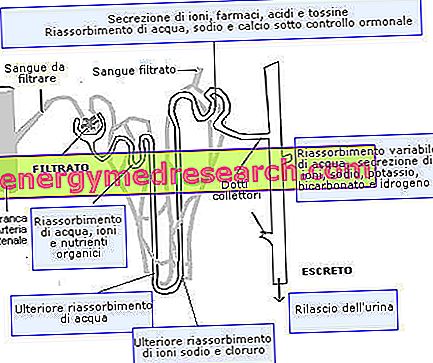Generality
Calciuria is a laboratory index that measures the amount of calcium filtered by the kidneys and excreted in the urine .
This exam allows the screening, diagnosis and monitoring of various conditions associated with alterations in calcium metabolism (including malnutrition, thyroid and bowel diseases, some cancers and nephropathies). Therefore, the dosage of calcium in the urine completes the picture provided by serum calcium (concentration of calcium in the blood).

What's this
Calciuria is a laboratory test that evaluates the concentration of calcium in the urine. This is a complementary survey, useful for investigating the metabolism of calcium in the body, which mainly involves three hormones: calcitonin, parathormone and calcitriol (activated vitamin D).
Why do you measure
The determination of calciuria can be performed to check for any parathyroid gland dysfunctions and to understand if kidney stones are the consequence of an excessive concentration of calcium in the urine.
The dosage of the mineral is performed by collecting the urine for 24 hours, with the foresight to control the calcium food intake in the 2-3 days preceding the examination (for example 1, 000 mg a day).
Together with calciuria, a test can be performed to assess creatinine clearance, a very important index of renal function, and a test to measure parathormone levels.
When is the exam prescribed?
The doctor may indicate the measurement of calcium in the urine when the outcome of the calcemia is abnormal, or when the patient complains of symptoms of kidney stones, such as sharp pain in the back around the kidneys, which can progress slowly to the abdomen, and / or blood in the urine.
The evaluation of calciuria is used to measure the amount of calcium eliminated with urine following filtration at the level of the renal glomerulus.
Calciuria alterations are associated with the same pathological conditions that affect serum calcium. In other words, an increase in the elimination of calcium with urine usually occurs when the level of the mineral in the plasma is increased (as in hyperthyroidism, intoxication by vitamin D and in multiple myeloma).
To get a more complete picture, the doctor can compare the results of the serum test with those of other blood tests, in particular with the evaluations of:
- Parathormone and vitamin D, substances involved in maintaining calcium balance;
- Albumin, the main plasma protein that binds calcium;
- Phosphorus;
- Magnesium.
Normal values
The normal value of calciuria is less than 4 mg per kilo of weight in the 24 hours, and is therefore on average between 100 and 250 mg / 24 h (women) and between 100 and 300 mg / 24 h (men).
The reference values can however vary slightly from laboratory to laboratory, also in relation to the calcium content of the diet.
Calciuria, urine calcium | |
Low calcium intake diet | Less than 150 mg / 24h or less than 3.7mmol / 24h |
Medium calcium intake diet | 100-250 mg / 24h or 2.5-6.2 mmol / 24 h |
High calcium intake diet | 250-300 mg / 24h or 6.2-7.5 mmol / 24h |
Regulation of urinary calcium excretion
Normally the calciuria of an adult is equal to 200 mg / day; in fact, about 98-99% of the calcium filtered by the renal glomerulus (10 grams per day) is reabsorbed: 60% at the level of the proximal convoluted tubule - through an active process closely connected with sodium reabsorption - and the remaining 40% in subsequent sections of the nephron.

At the level of the distal convoluted tubule, where about 10% of the filtered calcium is reabsorbed, there exists a hormonal control mediated by the parathyroid hormone and activated vitamin D; these hormones promote the reabsorption of calcium, which passes from preurine to blood, reducing calciuria and increasing calcemia (calcium concentration in the blood). Calcitonin also promotes the reabsorption of calcium, but unlike the parathormone, it stimulates the deposition of the mineral in the bones, reducing calcemia.
High Calciuria - Causes
Hypercalciuria, ie a concentration of urinary calcium above the value considered normal, can occur in the following cases:
- Hyperparathyroidism: increased parathyroid gland function, usually due to benign tumors;
- Renal insufficiency: deficient organ function, which does not adequately absorb the filtered mineral and causes an increase in its concentration in the urine;
- Excessive intake of vitamin D or calcium-rich foods;
- Idiopathic hypercalciuria: the causes of the phenomenon are not known;
- Hyperthyroidism and thyrotoxicosis: excess of thyroid hormones;
- Use of some drugs: loop diuretics (such as furosemide), calcium based antacids (calcium carbonate), thyroid hormones (eutirox);
- Other causes:
- Dehydration;
- Sarcoidosis;
- Bone fractures;
- Prolonged immobilization;
- High-protein diet;
- Sodium-rich diet;
- Tumors with metastases to the bones (typical is the case of breast cancer and lung cancer);
- Tumors that release substances similar to parathormone (paraneoplastic syndrome);
- Paget's disease.
Low Calciuria - Causes
Hypocalciuria, ie a lower urinary calcium concentration, can be detected in the following cases:
- Hypoparathyroidism;
- Vitamin D deficiency;
- Use of thiazide diuretics and lithium salts;
- Malabsorption syndromes;
- Increased calcium requirement in the body, as occurs during growth, pregnancy and lactation.
How to measure it
Calciuria is measured on a urine sample collected at a certain time of the day (random) or during the 24 hours.
Preparation
Urine collection
The collection of urine must be started in the morning, discarding those of the first urination, but marking the time of their issue. From this moment on, for the next 24 hours, all the urine expelled from the body must be collected in the special container provided by the analysis center. In order to avoid the loss of the same, as well as contamination with faeces, hair, etc., it is good to urinate in a small container and transfer the contents into the larger one, without touching the internal walls.
Between one urination and another, this container must be kept tightly closed in the refrigerator.
Urine collection ends at the end of 24 hours, with complete urination (trying to urinate even in the absence of stimulation). The container must therefore be marked with its name, surname, date and time of collection, and delivered to the analysis laboratory according to instructions.
In women of child-bearing age, urine collection should not be performed during menstruation, due to the risk of sample contamination.
Interpretation of Results
- Excess calcium in urine ( hypercalciuria ) may derive from nutrition or depend on the same causes that cause hypercalcaemia:
- hyperthyroidism,
- excessive introduction of vitamin D,
- patient enticement
- sarcoidosis.
- Low calcium in urine ( hypocalciuria ) may be the consequence of conditions that cause hypocalcemia, such as:
- liver disease,
- malnutrition,
- hypoparathyroidism,
- extreme dietary calcium deficiency,
- decrease in vitamin D concentration,
- acute inflammation of the pancreas (pancreatitis)
- kidney failure.
High calciuria values may also depend on an increase in parathyroid gland function (hyperparathyroidism) or a widespread neoplastic process to the bones.



